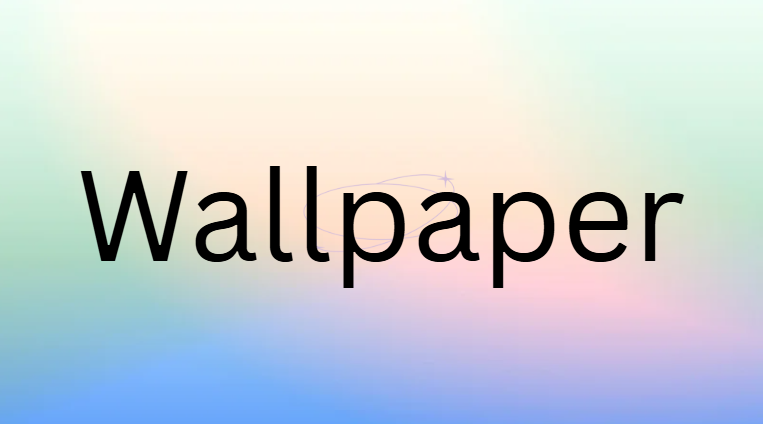Wallpaper is one of the easiest and most creative ways to decorate your home or office walls. It adds color, texture, and personality to any room. Instead of painting walls, wallpaper allows you to explore endless designs—from elegant floral patterns to modern geometric shapes. With today’s wide range of styles, materials, and installation options, wallpaper has become a top choice for people who want to give their space a unique and stylish look.
2. What is Wallpaper?
Wallpaper is a decorative material used to cover and design the interior walls of homes, offices, and other buildings. It is usually sold in rolls and applied to walls with a special adhesive or peel-and-stick backing. Unlike paint, wallpaper can display detailed designs, 3D textures, and luxurious finishes.
There are different types of wallpaper available, including vinyl, fabric, paper, and natural fiber designs. Each type offers its own unique features, durability, and level of maintenance.
3. Types of Wallpaper
a. Vinyl Wallpaper
Vinyl wallpaper is the most common and durable type. It’s easy to clean, water-resistant, and perfect for kitchens or bathrooms.
b. Paper Wallpaper
Paper wallpaper offers beautiful prints and is eco-friendly, but it can be less durable compared to vinyl. It’s best used in low-traffic areas like bedrooms or studies.
c. Fabric Wallpaper
Fabric wallpaper gives a luxurious and elegant look. It’s soft to the touch and often used in living rooms or hotels for a premium finish.
d. Peel and Stick Wallpaper
This modern type is very popular because it’s easy to apply and remove. Perfect for renters, it requires no glue—just peel off the backing and stick it to the wall.
e. Textured Wallpaper
Textured wallpapers add depth and character to walls. They can mimic stone, wood, or brick, giving your space a unique natural look.
4. Benefits of Using Wallpaper
a. Easy to Install and Remove
Modern wallpapers, especially peel-and-stick types, are simple to apply and remove without damaging the wall.
b. Long-Lasting
High-quality wallpaper can last up to 10–15 years, making it a great investment for home decor.
c. Wide Range of Designs
From simple stripes to complex 3D art, wallpaper offers endless design possibilities.
d. Covers Imperfections
Wallpaper can easily hide wall cracks, dents, or uneven surfaces better than paint.
e. Cost-Effective
Though the initial cost might be higher than paint, its durability and long life make it cost-effective in the long run.
5. How to Choose the Right Wallpaper
a. Consider Room Function
Choose wallpaper that matches the room’s purpose. For example, use moisture-resistant vinyl in bathrooms and soft, elegant designs in bedrooms.
b. Match the Color Scheme
Make sure the wallpaper colors complement your furniture, curtains, and flooring.
c. Check Lighting
In darker rooms, go for lighter shades to make the space look bright and spacious. In bright rooms, bold and dark tones can create a cozy feeling.
d. Think About Texture
Textured wallpaper can add warmth and depth, while smooth wallpaper gives a clean, modern look.
e. Measure the Wall Area
Always measure your wall before purchasing to avoid running out of wallpaper or buying too much.
6. Wallpaper Installation Tips
- Clean and smooth the wall surface before applying.
- Mark straight lines to align each wallpaper strip.
- Apply adhesive evenly (for traditional wallpaper).
- Start from the top and smooth out air bubbles as you go down.
- Trim extra edges carefully with a sharp knife.
For peel-and-stick wallpapers, just peel the back layer and stick the wallpaper smoothly to the wall, pressing out any bubbles.
7. Wallpaper Maintenance
Maintaining wallpaper is quite simple:
- Dust it regularly using a soft, dry cloth.
- For vinyl wallpapers, you can wipe gently with a damp sponge.
- Avoid using harsh chemicals or too much water.
- Check for any loose edges and fix them with wallpaper glue.
Proper care ensures your wallpaper remains bright and beautiful for years.
8. Latest Wallpaper Trends
- Nature-Inspired Designs – Wallpapers featuring flowers, leaves, and landscapes bring a refreshing outdoor vibe indoors.
- Geometric Patterns – Clean lines and bold shapes add a modern, stylish look.
- 3D Wallpapers – These create a realistic illusion of texture and depth.
- Minimalist Designs – Simple and elegant patterns are trending for modern homes.
- Metallic Finishes – Wallpapers with gold or silver accents give a luxurious touch.
9. Environmental Impact
Eco-friendly wallpaper options are becoming popular. Many brands now produce wallpapers made from recycled materials and non-toxic inks. These are safe for your family and the environment.
10. Conclusion
Wallpaper is a stylish and practical way to transform your walls. With so many types, patterns, and textures available, there’s something to suit every taste and budget. Whether you want a calm, cozy bedroom or a bold, modern living room, wallpaper helps express your personality and enhance your space beautifully.
FAQs
Q1: Is wallpaper better than paint?
Wallpaper lasts longer and offers more design options than paint. However, paint is easier to change if you like to update your decor often.
Q2: Can I apply wallpaper myself?
Yes! Peel-and-stick wallpaper is designed for easy DIY installation without professional help.
Q3: How long does wallpaper last?
Good-quality wallpaper can last 10–15 years or more with proper care.
Q4: Is wallpaper safe for bathrooms?
Yes, but you should use waterproof vinyl wallpaper to resist moisture and steam.
Q5: Can I put wallpaper on any surface?
It’s best to apply wallpaper on clean, smooth, and dry walls. Rough or damp walls can cause the wallpaper to peel.
